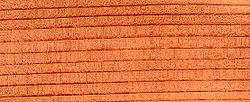Wood
Wood is what keeps trees and shrubs upright, and what transports water from the roots to the leaves. The two main chemical substances in wood are cellulose and lignin.
Wood is formed in trees and shrubs by the cambium, a cell layer between bark and wood. The result is that wood is formed in circular rings, which are called growth rings.
The wood in the centre of the tree or shrub may have a different color from that on the outside. In that case, the wood on the outside is light in color, and is called "sapwood"; the wood in the centre is darker in color, and is called "heartwood". Most often, heartwood is more resistant to rot than sapwood. Not all trees and shrubs form heartwood, and it is also possible that heartwood differs very little in color from the sapwood, or not at all.
Use of wood
Wood is used to make buildings and furniture, and also for art. Firewood is a fuel. Paper is made from wood fibres. Wood is a renewable resource although it has become scarcer in recent centuries. Its origin is about 425 million years ago.[1]
Wood is hard to cut, but it is also strong. A lumberjack is a person who cuts down trees. After a tree falls, the wood in it can be cut into long, straight pieces called lumber. Lumber can then be used to make posts, or put together with nails, screws, or even glue to make wooden frames for other shapes.
Wood comes in many different kinds. Oak, maple (hardwood) and pine and redwood (softwood) are widely used types of wood. Woods are usually divided into softwood (from conifers) and hardwood from flowering plants.[2]
Housing
For a long time and even today, many buildings, mostly houses, have been made of wood. To build a house with wood, lumber is put together into frames that are the shape of each wall, floor, and roof of the house. Then the frames are placed into the shape of a house. Then the frames can be covered to make solid walls. Sometimes the walls are made of more wood.
When the outside of a house or building is covered in wood, the wooden pieces are usually flat and stacked. These pieces are called shingles. Wood is also sometimes used in other parts of the house, like doors and staircases. Wood is also used to make fences.
Carpentry

Carpenters make houses of mostly soft wood such as pine. For many kinds of furniture they use harder wood such as maple or oak. When someone builds something with wood, they often paint it. Paint protects and beautifies the wood. Some people like the look of wood, so they put clear paint called varnish on it. This helps to protect the wood and gives it a shiny finish.
Some people make art with wood. Sometimes sculptures are built with wood: see Grinling Gibbons.
Regular pencils are made of wood. Inside is the "lead", which is not actually lead. Clay or wax and graphite form the "lead" in a pencil.
Paper
Wood is turned into paper in large factories called paper mills. Heat, chemicals and machines separate the cellulose fibers from other parts and press the fibers into paper.
Wood Media
Diagram of secondary growth in a tree showing idealized vertical and horizontal sections. A new layer of wood is added in each growing season, thickening the stem, existing branches and roots, to form a growth ring.
The wood of coast redwood is distinctively red.
Magnified cross-section of black walnut, showing the vessels, rays (white lines) and annual rings: this is intermediate between diffuse-porous and ring-porous, with vessel size declining gradually
Earlywood and latewood in a softwood; radial view, growth rings closely spaced in Rocky Mountain Douglas-fir
Earlywood and latewood in a ring-porous wood (ash) in a Fraxinus excelsior; tangential view, wide growth rings
References
- ↑ Labandeira C. 2007. The origin of herbivory on land: Initial patterns of plant tissue consumption by arthropods. Insect Science. 14 (4): 259–275. [1]
- ↑ Jane F.W. 1970. The structure of wood. 2nd ed, edited by K. Wilson & D.J.B. White. London: Adam & Charles Black. ISBN 9780713609127
Related pages
| Wikimedia Commons has media related to Lua error in Module:Commons_link at line 62: attempt to index field 'wikibase' (a nil value).. |
Other websites
- Wood -Citizendium










